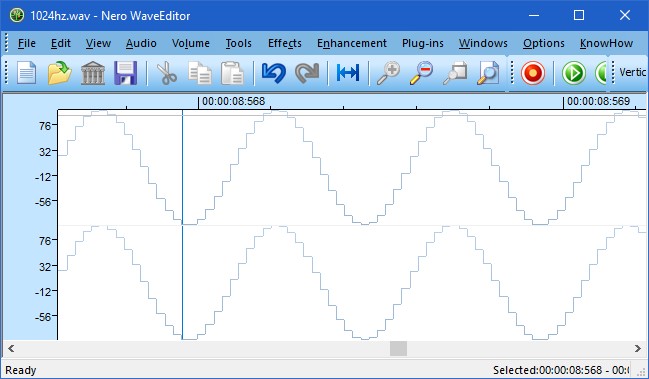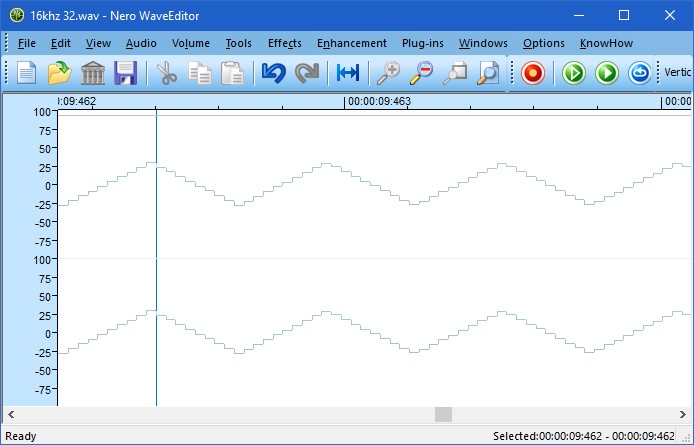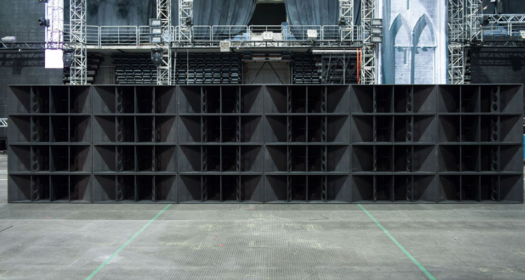This is not a direct answer to your question. What you need is not a direct answer because in order to carry out your intentions successfully you will need to know exactly what you are doing. Infrasound is a different world. Recording infrasound is much like exploring the mariana trench or deep space. You will not get far if you don't know where you're going and buying an expensive microphone alone will get you exactly nowhere. I bring a lot of background information so prepare for a long read.
First of all: Artifacts
I assume you are not only speeding up the sound, but simultaneously transposing it. So by speeding it up 4x you are transposing everything by 2 octaves. Speeding up by 1024x transposes your sound by 10 octaves. This means that 20 hz waves will turn into 20480hz waves and 1hz waves will turn into 1024 waves. Transposing or frequency shifting sound past the sample rate can and will cause artifacts that will be audible in the lower frequency ranges.
Therefore I recommend you to apply very strong HighCut filters and to go step by step:
- Add a BUT48 high-cut filter at 5khz
- Repeat Step 1 at least 2 more times
- ONLY Transpose by 1 octave = Speed up sound 2x
- Repeat step 1-3 as many times as you want.
Save every file with the maximum Bit-depth and sample rate possible. Therefore you should be looking forwards to accelerating sound 1024x not 900x. Why? let me explain:
How Artifacts happen
This is a 1024hz wave at a sample rate of 44.1khz

2048hz at a sample rate of 44.1khz

4096hz

8192hz

16192hz

Now this does not even come close to a sinewave anymore. You see the highest note you can playback with a sample rate of 44.1khz is a 22050hz triangle wave.

Yes, it looks like a Square wave in nero Wave Editor but really it's a triangle wave. Actually it's not possible at all to re-create a pure square wave because they require an infinite samplerate (You would need 2 datapoints, one at the top and one at the bottom, at the same timeframe. That is not possible)

The important thing we need to understand is that when speeding up sound by a factor of 2 the software will pick Data Point 1 & Data Point 2 and average them creating the new Data Point 1. Then it will pick Data Point 3 & Data Point 4 and average them creating the new Data Point 2, and so on. Nero Wave Editor has a different approach: he starts with Data Point 1 and simply ignores every other Data Point. Transposing a 22050hz wave by 1 octave looks like this. Dead Silence with an offset:

Now instead of transposing it by an octave I transposed 22050hz by 11 Semitones. And what do we get? Instead of a 41644hz sine wave we suddenly have a 2450hz triangle wave! Oops!

This is why it's so important to high-cut the high sounds before transposing and only transposing by a factor of 2.
Some people here in the answers expressed their doubts about their computers being able to handle infrasound frequencies. Lol. I beg to differ. This is 0.015625hz and we could go much, much, much, much lower than that.

Now that you know how to transpose properly you want to record Infrasounds and make them audible and analyze them on a Spectrum Analyzer, right?
The correlation between frequency and membrane diameter
Because loudspeakers are my field of knowledge more so than microphones I will provide examples with loudspeakers but the principles are the same. A Subwoofer with a membrane diameter of 46cm and a moving mass of 200g will not be able to reproduce a 20khz note with a lot of volume. It has nothing to do with the weight of the membrane and everything to do with stiffness. If you send a 20khz note throuh a large Subwoofer the membrane will not oscillate uniformly. It will look a lot worse than this:

Now if you take a very small loudspeaker with a membrane diameter of 8cm and pass a 1hz sine wave through it the pressure will not be transmitted to the air around the speaker that is responsible for carrying sound to your ear. This is called a mismatch in acoustic Impedance. The air does not absorb and transmit the pressure wave but instead it moves out of the way of the speaker. Let's not get into the math of this but it's very much like trying to paddle a boat with a small stick. The water will simply flow around the stick.
In order to properly transmit a 1hz sine wave you would need an immense membrane, hundreds of metres in diameter. Horn speakers are a cheap fix. Technology does not allow us to create membranes of sufficient size therefore we connect horns to small membranes. Large membranes would prove horn systems useless. A small membrane 30cm in diameter is too small to properly transmit bass frequencies into the air. A long-throw horn system will couple the membrane to the air more efficiently and match the acoustic impedance.

Or you start stacking these, also called an URPS:

The same applies to microphones. A microphone will pick up sounds that have a matching acoustic impedance with more volume than other sounds.
What is sound?
We know sound is molecules vibrating. But we have different factors for determining volume in air. Air pressure and velocity.
Sound can be rapidly moving air at extreme speeds with low pressure (such as the port of a subwoofer)
The reason the girls eardrums are not ruptured at 160db+ is because the ear canal is too narrow, the frequency too low and the air pressure too low to efficiently transmit the energy of the air vibrating at such a high velocity to her eardrum: her surroundings have a very low acoustic Impedance which results in a mismatch.
Imagine the following picture was a vibrating tuning fork and you had a microphone at a reasonable distance next to it with a membrane of the microphone 10x larger in diameter than the wavelength of the vibrating air. The soundwave would successfully cause the membrane of the microphone to oscillate back and forth in unison.

Now imagine the picture above was a giant nuclear device pulsating at 0.01hz. And you were unfortunately close next to it sitting in this house with a small microphone:
You can see the winds pushing back and forth on the house. Air moving from areas of high pressure to areas of low pressure. Acoustic Impedance is too low to catch the pressure wave with your microphone. The microphone would need to be immensely huge.
Sound is not only air moving back and forth, it also manifests as a pressure. If you look at the yellow animated picture again you can imagine the darker orange bits are areas of high pressure and the light yellow bits are areas of low pressure. Like in the weather forecast. You could measure these differences with a pressure gauge, convert them to a soundfile and transpose it with the method described above which is what you want right?
Before you run off and buy some expensive microphone keep in mind that sound comes in different levels of acoustic impedance.
And you will need different methods to capture each type.
- A pressure gauge (high impedance) is good for measuring pressure
differences and poor when it comes to recording wind or higher
frequencies.
- A fan (low impedance) is good for measuring the wind of a nuclear
explosion and useless for measuring pressure differences.
- A standard microphone (medium impedance) with a membrane will not
react to the wind of a nuclear explosion. It will not react to
weather changes either because the pressure changes too slowly. If
you want to catch the weather change with a standard electrodynamic
microphone you would need different air pressure behind the membrane
than in front of the membrane in order for the membrane to move. An
electrodynamic microphone works by pushing a voice coil through a
magnet which generates electricity. A voice coil moving at 0.01hz
through a magnet would not generate enough energy to be measurable.
Now before you run off and buy some expensive microphone remember that you need a measurement tool that has a matching impedance with the sound that you want to measure. Acoustic Impedance is everything. Membranes are simply much too small compared to the wavelength which causes these massive differences in impedance between different methods of recording infrasound. You will need to choose your method wisely.
If you just start measuring with the B&K Type 4193 microphone recommended above you will have no idea what you are measuring. You will get a lot of unidentifiable random noise.
If you are aware of what you are recording and you understand acoustic impedance you will automatically know what tool you will need for the job without asking people online. And thanks to me you will know how to properly process the soundfile. Don't waste money. Know what you are doing.














